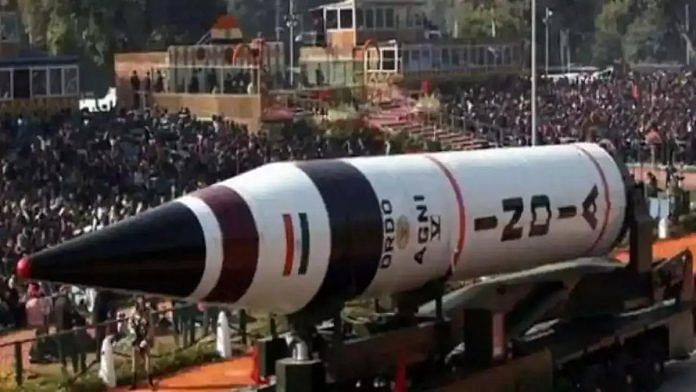Thank you dear subscribers, we are overwhelmed with your response.
Your Turn is a unique section from ThePrint featuring points of view from its subscribers. If you are a subscriber, have a point of view, please send it to us. If not, do subscribe here: https://theprint.in/
As the world enters an era defined by volatile geopolitics, climate urgency, and technological disruption, India stands at a critical crossroads. On one hand, India aspires to emerge as the global industrial and manufacturing counterweight to China; on the other, it must maintain its dominance in the knowledge and digital services economy. Both goals demand one indispensable resource — consistent, scalable, and clean energy. Yet India’s current energy trajectory, dominated by coal, hydrocarbon imports, and intermittent renewables, is ill-equipped to shoulder the weight of this ambition.
If India is serious about securing its future, it must go full throttle in embracing nuclear power — not as a reluctant supplement, but as the backbone of its energy ecosystem. The real tragedy is not that India lacks the capability or international goodwill to do this, but that its own political orthodoxy around the Nuclear Non-Proliferation Treaty (NPT) and its ambiguous liability regime have held it back from unleashing the full potential of nuclear energy.
Why Nuclear? Why Now?
Nuclear energy offers what India desperately needs: base-load power that is clean, reliable, and free from the volatility of global fossil fuel markets. For a country with ambitions to become the next factory of the world — as global firms look to de-risk from China — dependable electricity is non-negotiable.
Moreover, as India’s AI, quantum computing, and data-driven services economy matures, gigantic data centres will become the arteries of its economic engine. These facilities are energy guzzlers, and running them on solar or wind, which are plagued by intermittency and storage issues, is a pipedream without costly batteries — ironically, many made in China. In contrast, nuclear power can offer round-the-clock energy at scale, making it the obvious choice for powering India’s industrial and digital leap.
The Trouble with the Current Alternatives
Solar and Wind: While politically attractive and media-friendly, India’s current renewable push is deceptively fragile. It is overdependent on Chinese battery giants like CATL and BYD for grid storage and lacks domestic capability to manufacture high-quality renewable equipment at scale. Beyond economics, this creates a national security risk: as Israel demonstrated in Lebanon, even basic battery technology can be weaponised. Imagine the vulnerabilities in an ecosystem where your power storage depends on a hostile neighbour’s export controls or embedded malware.
Gas and Coal: India does not possess abundant high-calorific gas or coal reserves. To expand gas-fired power, it would need to invest billions in extraction and pipeline infrastructure, only to lock itself into another dirty fuel source that jeopardises its net-zero goals. Moreover, Western coal exporters like Australia are politically turning away from fossil fuel exports, making Indian attempts to secure offshore coal mines increasingly untenable. Coal mining in India also leads to irreparable ecological damage — a politically and environmentally unsustainable proposition.
Nuclear Energy: The Clean, Scalable Answer
Nuclear power plants can provide the uninterrupted, large-scale electricity necessary for India to traverse the path to true energy independence, net-zero targets, and strategic geopolitical positioning in an uncertain world, ensuring India’s digital future is secure and self-reliant. Replacing ageing coal-fired power plants with nuclear ones can also leverage existing transmission and distribution infrastructure, leading to significant cost optimization.
The key impediment to India’s nuclear ambitions lies in its refusal to sign the NPT, a stance rooted in its military nuclear program. While India has demonstrably established itself as a nuclear triad power, proving its military might, this military-driven nuclear posture should not hinder its civilian energy security. The global reaction to Russia’s nuclear sabre-rattling in Ukraine clearly illustrates the futility of such posturing in a conventional conflict. By embracing the NPT and seeking membership in the Nuclear Suppliers Group (NSG), India can unlock access to enriched uranium for civilian uses from countries like Russia, France, and the UK, and operate under regular IAEA inspections, signalling its commitment to peaceful nuclear energy.
Addressing the nuclear liability framework, as highlighted by the Civil Liability for Nuclear Damage Act (CLNDA), is crucial for attracting foreign investment and technology. The current framework places no-fault liability on operators while allowing recourse against suppliers. While Prime Minister Modi’s agreement with US President Obama in 2015 to limit US supplier liability through an insurance pool was a step forward, a more comprehensive approach is needed. A robust project finance framework, where nuclear power plant equipment and technology suppliers, along with operators, are offered equity stakes in the project and representation on the board, can foster joint shared ownership and oversight. This incentivizes all stakeholders to ensure safety and due diligence throughout the plant’s life. Furthermore, this joint ownership structure would encourage Western technology and plant equipment suppliers to leverage their influence with Western financial institutions to secure insurance for potential technology, equipment, or protocol failures, thereby de-risking investments and accelerating nuclear power deployment.
India’s ambition to triple nuclear power generation capacity by 2030 and reach 100 GW by 2047 is not merely an energy target; it is a strategic imperative to counter geopolitical uncertainties, establish itself as an industrial manufacturing powerhouse, and secure its future as a leader in the global services sector. By strategically navigating the NPT issue and implementing a progressive liability framework, India can truly unleash its nuclear potential and become a beacon of clean energy for the Global South.
These pieces are being published as they have been received – they have not been edited/fact-checked by ThePrint.


